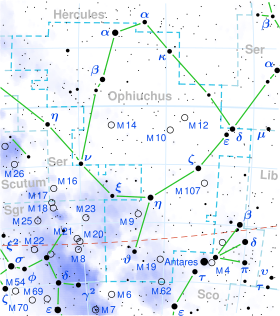Top Qs
Timeline
Chat
Perspective
72 Ophiuchi
Binary star system in the constellation Ophiuchus From Wikipedia, the free encyclopedia
Remove ads
72 Ophiuchi is a binary star[3] system in the equatorial constellation of Ophiuchus. It is visible to the naked eye as a faint, white-hued point of light with a combined apparent visual magnitude of 3.73.[2] It is located approximately 86.9 light years away from the Sun based on parallax,[1] but is moving closer with a heliocentric radial velocity of -23.9 km/s.[5]
As of 2008, the pair had an angular separation of 25″.[3] According to Gray et al. (2003), the primary component has a stellar classification of A5 V,[4] matching an A-type main-sequence star. Cowley et al. (1969) had assigned it to a class of A4 IVs,[11] suggesting it is a sharp-lined (s) subgiant star. The latter class is still in use by some sources.[7][3][12]
The primary is 250[9] million years old with double[7] the mass of the Sun and is spinning with a moderate projected rotational velocity of 65 km/s.[7] It is radiating 20[7] times the luminosity of the Sun from its photosphere at an effective temperature of 8,718 K.[9] It displays an infrared excess, suggesting a debris disk is orbiting the star with a mean separation of 82.96 AU and temperature of 60 K.[13] The system is a source of X-ray emission,[12] which is most likely coming from the 14th[3] magnitude companion.[12]
There are additional visual companions: component C with magnitude 11.5 lies at an angular separation of 64″ from the primary,[14] while component D, has magnitude 14.8 and separation 24".[15]
This star was once considered part of the obsolete constellation Taurus Poniatovii, the brightest star in it. After the International Astronomical Union officially recognised constellations, it was placed in Ophiuchus.[16]
Remove ads
References
Wikiwand - on
Seamless Wikipedia browsing. On steroids.
Remove ads

